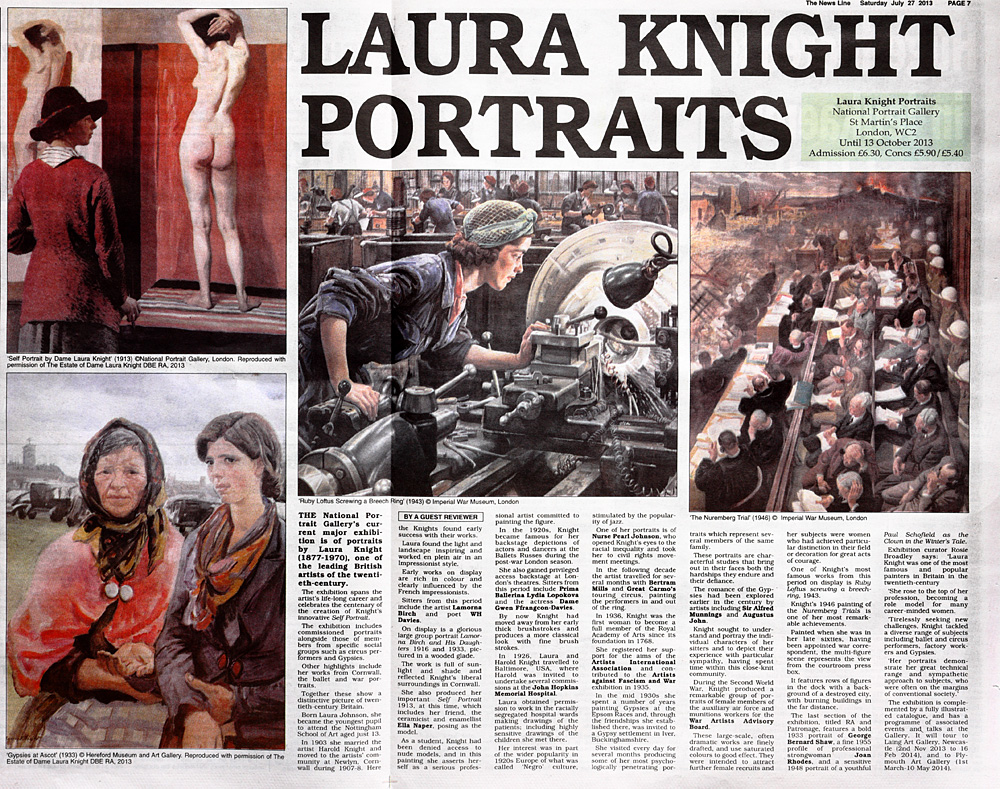 |
| The News Line Saturday July 27
2013 Page 7 LAURA KNIGHT PORTRAITS BY A GUEST REVIEWER Laura Knight Portraits National Portrait Gallery St Martin's Place, London, WC2 Until 13 October 2013 Admission 6.30 UK pounds, Concs 5.90/5.40 UK pounds THE National Portrait Gallery's current major exhibition is of portraits by Laura Knight (1877-1970), one of the leading British artists of the twentieth-century. The exhibition spans the artist's life-long career and celebrates the centenary of the creation of Knight's Innovative Self Portrait. The exhibition includes commissioned portraits alongside those of members from specific social groups such as circus performers and Gypsies. Other highlights include her works from Cornwall. the ballet and war portraits. Together these show a distinctive picture of twentieth-century Britain. Born Laura Johnson, she became the youngest pupil to attend the Nottingham School of Art aged just 13. In 1903 she married the artist Harold Knight and moved to the artists' community at Newlyn, Cornwall during 1907-8. Here the Knights found early success with their works. Laura found the light and landscape inspiring and worked en plein air in an Impressionist style. Early works on display are rich in colour and clearly influenced by the French impressionists. Sitters from this period include the artist Lamorna Birch and poet WH Davies. On display is a glorious large group portrait Lamorna Birch and His Daughters 1916 and 1933. pictured in a wooded glade. The work is full of sunlight and shade and reflected Knight's liberal surroundings in Cornwall. She also produced her important Self Portrait 1913, at this time. which includes her friend. the ceramicist and enamellist Ella Naper, posing as the model. As a student. Knight had been denied access to nude models, and in this painting she asserts herself as a serious professional artist committed to painting the figure. In the 1920s. Knight became famous for her backstage depictions of actors and dancers at the Ballets Russes during the post-war London season. She also gained privileged access backstage at London's theatres. Sitters from this period include Prima Ballerina Lydia Lopokova and the actress Dame Gwen Ffrangcon-Davies. By now Knight had moved away from her early thick brushstrokes and produces a more classical look with fine brush strokes. In 1926, Laura and Harold Knight travelled to Baltimore, USA. where Harold was invited to undertake several commissions at the John Hopkins Memorial Hospital. Laura obtained permission to work in the racially segregated hospital wards making drawings of the patients; including highly sensitive drawings of the children she met there. Her interest was in part of the wider popularity in 1920s Europe of what was called 'Negro' culture, stimulated by the popularity of jazz. One of her portraits is of Nurse Pearl Johnson, who opened Knight's eyes to the racial inequality and took her to civil rights movement meetings. In the following decade the artist travelled for several months with Bertram Mills and Great Carmo's touring circus, painting the performers in and out of the ring. In 1936, Knight was the first woman to become a full member of the Royal Academy of Arts since its foundation in 1768. She registered her support for the aims of the Artists International Association and contributed to the Artists against Fascism and War exhibition in 1935. In the mid 1930s she spent a number of years painting Gypsies at the Epsom Races and through the friendships she established there was invited to a Gypsy settlement in Iver, Buckinghamshire. She visited every day for several months producing some of her most psychologically penetrating portraits which represent several members of the same family. These portraits are characterful studies that bring out in their faces both the hardships they endure and their defiance. The romance of the Gypsies had been explored earlier in the century by artists including Sir Alfred Munnings and Augustus John. Knight sought to understand and portray the individual characters of her sitters and to depict their experience with particular sympathy, having spent time within this close-knit community. During the Second World War, Knight produced a remarkable group of portraits of female members of the auxiliary air force and munitions workers for the War Artists Advisory Board. These large-scale, often dramatic works are finely drafted, and use saturated colours to good effect. They were intended to attract further female recruits and her subjects were women who had achieved particular distinction in their field or decoration for great acts of courage. One of Knight's most famous works from this period on display is Ruby Loftus screwing a breech-ring, 1943. Knight's 1946 painting of the Nuremberg Trials is one of her most remarkable achievements. Painted when she was in her late sixties, having been appointed war correspondent, the multi-figure scene represents the view from the courtroom press box. It features rows of figures in the dock with a background of a destroyed city, with burning buildings in the far distance. The last section of the exhibition, titled RA and Patronage, features a bold 1933 portrait of George Bernard Shaw, a fine 1955 profile of professorial strongwoman Joan Rhodes, and a sensitive 1948 portrait of a youthful Paul Schofield as the Clown in the Winter's Tale. Exhibition curator Rosie Broadley says; 'Laura Knight was one of the most famous and popular painters in Britain in the twentieth -century. 'She rose to the top of her profession. becoming a role model for many career-minded women. 'Tirelessly seeking new challenges. Knight tackled a diverse range of subjects including ballet and circus performers, factory workers and Gypsies. 'Her portraits demonstrate her great technical range and sympathetic approach to subjects, who were often on the margins of conventional society.' The exhibition is complemented by a fully illustrated catalogue. and has a programme of associated events and talks at the Gallery. It will tour to Laing Art Gallery. Newcastle (2nd Nov 2013 to 16 Feb 2014), and to Plymouth Art Gallery (1st March- May 2014). http://www.wrp.org.uk |